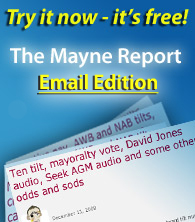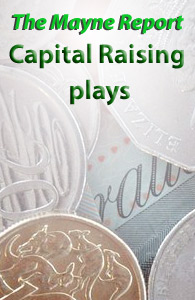ASX responds and special end of profit season wrap
February 2, 2010
Dear Mayne Reporters,
First things first, the ASX appears to be moving in response to the forthcoming board tilt, as they unveiled this guidance note on Thursday night which makes some improvements to the regime which allowed all those appallingly governed Babcock and Macquarie vehicles to be listed in Australia.
The model is clearly dead so in some senses this is yesterday's fight with a broader issue being the way that the ASX board is dominated by promoters and issuers of vehicles, such as the two old UBS boys, Michael Sharpe from Babcock and Peter Warne from Macquarie. Investor representatives are few and far between.
This board composition, plus the enormous pressure to lower standards and maximise profits, conspired to make Australia something of a Wild West when it came to governance and disclosure for these third party listed funds and we're now seeing the ugly end game with huge fees still being gouged whilst investors lose their shirts.
Reporting season special
We've seen some hairy profit reporting seasons in our day but nothing quite like what was served up in August 2008, with the biggest losers listed in full here.
Thirty companies reported losses of more than $100 million for 2007-08 and we've got two new names in the top 5 Australian losses of all time, which now reads as follows:
1. News Corp 2001-02: $12 billion
2. AMP 2003: $5.53 billion
3. BHP 1998-00: $2.3 billion
4. Centro Properties Group 2007-08: $2.055 billion
5. Allco Financial Group 2007-08: $1.73 billion
Ten $100m-plus losses on Friday with many more to come
Check out this Crikey story today on how the remarkable ten $100 million-plus losses unfolded on Friday, with six of them from the Allco stable.
What's is really frightening about the current situation is that many of the write-downs and losses didn't go nearly far enough. How on earth did Babcock & Brown report a profit when its claimed net assets of $2.5 billion is three times its current market capitalisation of $800 million?
The key swing factor which explains whether write-offs are comprehensive enough is usually driven by the presence of a new broom board and management.
The Babcock & Brown result was finalised on the day Phil Green and Jim Babcock exited but with finance director Michael Larkin and Elisabeth Nosworthy taking over they didn't fancy painting themselves black with the $1 billion-plus loss that should have been declared.
Here is an example of two other companies that should have declared bigger losses:
Geo Property Group: the former MFS Diversified Trust took a mild swipe at balance sheet values to deliver a net loss of $66 million but this was nowhere near enough because it now claims to have net assets of $300 million when the market capitalisation is just $124 million. As usual, it was the long-serving CEO Guy Farrands who refused to accept reality and auditor Tim Allman from PwC clearly agreed and signed the accounts as "true and fair" on August 28.
Record Realty: came out this morning with a belated $209 million net loss but this only reduced the NTA claim to 32c a share or $131 million, when the market capitalisation is only $13 million whilst the stock wallows below 4c.
Where to for ABC Learning?
There are lots of rumours that ABC Learning is about to go broke and if that happens it will be a record because the company claims to have net assets of $2.23 billion, yet its market capitalisation is only $296 million.
Clearly, the market believes a $2 billion write-down is coming but if ABC Learning goes under, it will win the dubious prize of having the strongest balance sheet on paper of any collapsed company in Australian history. No wonder there's a big battle going on with new auditor Brian Long, the Ernst & Young partner who signed off on AMP's claimed $18 billion in net assets back in 2003, when the market was valuing the business at about $6 billion.
The following list tracks the claimed net assets of companies which collapsed and names the auditor involved:
Claimed assets of companies at time of collapse
Pasminco: declared a $23 million net profit for 1999-00 and then collapsed whilst claiming to have net assets of $1.5 billion. Alan Beckett from Ernst & Young signed the accounts and then kept auditing the reborn Zinifex.
One-tel: collapsed in 2001 and the last published balance sheet claimed net assets of $945 million. Stephen La Greca from BDO Nelson Parkhill signed the accounts as auditor.
HIH Insurance: placed into liquidation on March 15, 2001 and the 1999-00 annual report claimed net assets of $953 million. John Buttle from the now-defunct Arthur Andersen was signing audit partner.
Sons of Gwalia: somehow reported a $12.23 million profit for the 6 months to December 2003 when this balance sheet claimed net assets of $728 million. Was in administration just a few months later, proving what an inaccurate picture was painted by all involved, including auditor VW Tidy from Ernst & Young's Perth office.
ION: the car part company collapsed in late 2004, but the 2003-04 results claimed a net profit of $29.7 million and $297.1 million in net assets. DA Watson from Deloittes signed these accounts as "true and fair" on September 17 and adminstrators were called in on December 7, 2004.
Check out Delisted summary of what happened after that.
Centaur Mining & Exploration: collapsed in May 2001 with $650 million in debts and the last annual report claimed it had net assets of $110 million. PKF's Michael Phillips was the audit signing partner.
Bill Express: collapsed in mid-2008 but the last accounts in February of that year claimed to have net assets of $66.45 million. The auditor was BW Szentirmay from KPMG.
Monarch Gold: Michael Kiernan's mining outfit collapsed in 2008 when it was claiming to have $58.45 million in net assets. The auditor was Peter Buchholz from PwC's Perth office.
Eisa: Damian Brady's house of cards collapsed shortly after the dot-com bubble burst but the 1999 annual report claimed net assets of $39.4 million with Roger Amos from KPMG the signing auditor.
Commander Communications: after the new CEO took an axe to the balance sheet in February 2008, the net assets were only at $20.68 million by the time it collapsed six months later. The final auditor was RD Dring from PwC.
There will be many more additions to this list over the coming months and if you've got any suggestions, drop us a line to stephen@maynereport.com.
That's all for now.
Do ya best, Stephen Mayne
* The Mayne Report is a multi-media governance website published by Stephen Mayne with occasional email editions. To unsubscribe from the emails click here.
First things first, the ASX appears to be moving in response to the forthcoming board tilt, as they unveiled this guidance note on Thursday night which makes some improvements to the regime which allowed all those appallingly governed Babcock and Macquarie vehicles to be listed in Australia.
The model is clearly dead so in some senses this is yesterday's fight with a broader issue being the way that the ASX board is dominated by promoters and issuers of vehicles, such as the two old UBS boys, Michael Sharpe from Babcock and Peter Warne from Macquarie. Investor representatives are few and far between.
This board composition, plus the enormous pressure to lower standards and maximise profits, conspired to make Australia something of a Wild West when it came to governance and disclosure for these third party listed funds and we're now seeing the ugly end game with huge fees still being gouged whilst investors lose their shirts.
Reporting season special
We've seen some hairy profit reporting seasons in our day but nothing quite like what was served up in August 2008, with the biggest losers listed in full here.
Thirty companies reported losses of more than $100 million for 2007-08 and we've got two new names in the top 5 Australian losses of all time, which now reads as follows:
1. News Corp 2001-02: $12 billion
2. AMP 2003: $5.53 billion
3. BHP 1998-00: $2.3 billion
4. Centro Properties Group 2007-08: $2.055 billion
5. Allco Financial Group 2007-08: $1.73 billion
Ten $100m-plus losses on Friday with many more to come
Check out this Crikey story today on how the remarkable ten $100 million-plus losses unfolded on Friday, with six of them from the Allco stable.
What's is really frightening about the current situation is that many of the write-downs and losses didn't go nearly far enough. How on earth did Babcock & Brown report a profit when its claimed net assets of $2.5 billion is three times its current market capitalisation of $800 million?
The key swing factor which explains whether write-offs are comprehensive enough is usually driven by the presence of a new broom board and management.
The Babcock & Brown result was finalised on the day Phil Green and Jim Babcock exited but with finance director Michael Larkin and Elisabeth Nosworthy taking over they didn't fancy painting themselves black with the $1 billion-plus loss that should have been declared.
Here is an example of two other companies that should have declared bigger losses:
Geo Property Group: the former MFS Diversified Trust took a mild swipe at balance sheet values to deliver a net loss of $66 million but this was nowhere near enough because it now claims to have net assets of $300 million when the market capitalisation is just $124 million. As usual, it was the long-serving CEO Guy Farrands who refused to accept reality and auditor Tim Allman from PwC clearly agreed and signed the accounts as "true and fair" on August 28.
Record Realty: came out this morning with a belated $209 million net loss but this only reduced the NTA claim to 32c a share or $131 million, when the market capitalisation is only $13 million whilst the stock wallows below 4c.
Where to for ABC Learning?
There are lots of rumours that ABC Learning is about to go broke and if that happens it will be a record because the company claims to have net assets of $2.23 billion, yet its market capitalisation is only $296 million.
Clearly, the market believes a $2 billion write-down is coming but if ABC Learning goes under, it will win the dubious prize of having the strongest balance sheet on paper of any collapsed company in Australian history. No wonder there's a big battle going on with new auditor Brian Long, the Ernst & Young partner who signed off on AMP's claimed $18 billion in net assets back in 2003, when the market was valuing the business at about $6 billion.
The following list tracks the claimed net assets of companies which collapsed and names the auditor involved:
Claimed assets of companies at time of collapse
Pasminco: declared a $23 million net profit for 1999-00 and then collapsed whilst claiming to have net assets of $1.5 billion. Alan Beckett from Ernst & Young signed the accounts and then kept auditing the reborn Zinifex.
One-tel: collapsed in 2001 and the last published balance sheet claimed net assets of $945 million. Stephen La Greca from BDO Nelson Parkhill signed the accounts as auditor.
HIH Insurance: placed into liquidation on March 15, 2001 and the 1999-00 annual report claimed net assets of $953 million. John Buttle from the now-defunct Arthur Andersen was signing audit partner.
Sons of Gwalia: somehow reported a $12.23 million profit for the 6 months to December 2003 when this balance sheet claimed net assets of $728 million. Was in administration just a few months later, proving what an inaccurate picture was painted by all involved, including auditor VW Tidy from Ernst & Young's Perth office.
ION: the car part company collapsed in late 2004, but the 2003-04 results claimed a net profit of $29.7 million and $297.1 million in net assets. DA Watson from Deloittes signed these accounts as "true and fair" on September 17 and adminstrators were called in on December 7, 2004.
Check out Delisted summary of what happened after that.
Centaur Mining & Exploration: collapsed in May 2001 with $650 million in debts and the last annual report claimed it had net assets of $110 million. PKF's Michael Phillips was the audit signing partner.
Bill Express: collapsed in mid-2008 but the last accounts in February of that year claimed to have net assets of $66.45 million. The auditor was BW Szentirmay from KPMG.
Monarch Gold: Michael Kiernan's mining outfit collapsed in 2008 when it was claiming to have $58.45 million in net assets. The auditor was Peter Buchholz from PwC's Perth office.
Eisa: Damian Brady's house of cards collapsed shortly after the dot-com bubble burst but the 1999 annual report claimed net assets of $39.4 million with Roger Amos from KPMG the signing auditor.
Commander Communications: after the new CEO took an axe to the balance sheet in February 2008, the net assets were only at $20.68 million by the time it collapsed six months later. The final auditor was RD Dring from PwC.
There will be many more additions to this list over the coming months and if you've got any suggestions, drop us a line to stephen@maynereport.com.
That's all for now.
Do ya best, Stephen Mayne
* The Mayne Report is a multi-media governance website published by Stephen Mayne with occasional email editions. To unsubscribe from the emails click here.





















